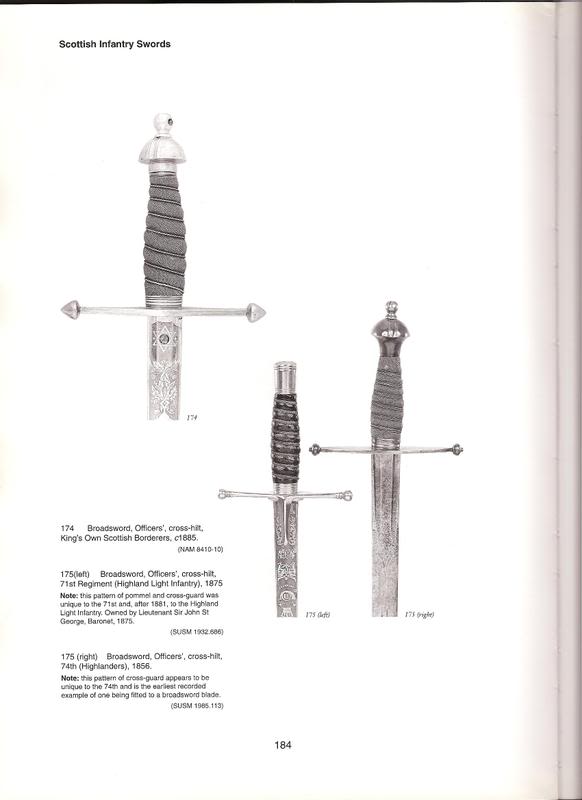hello,
someone could tell me where i can find pics of a 1865 cross hilt officer sword, as was worn in undress
order by highlands and lowlands regiments?
thanks
Normally I would recommend www.oldswords.com, but it is down for a few days while they update and upgrade the site. In the mean time, here are some threads from SFI on Victorian and early 20th century cross hilts:
http://forums.swordforum.com/showthread.php?t...t=scottish
http://forums.swordforum.com/showthread.php?t...t=scottish
http://swordforum.com/fall99/1865.html
I hope those are helpful. I will try to post some images later.
Jonathan
http://forums.swordforum.com/showthread.php?t...t=scottish
http://forums.swordforum.com/showthread.php?t...t=scottish
http://swordforum.com/fall99/1865.html
I hope those are helpful. I will try to post some images later.
Jonathan
From Robson's Swords of the British Army:


hi jonathan
excellent photos, i have been always courious to know the reason for the adoption of such anachronistic
(but really beautifull) sword pattern beyond the purely aestetical reason. Do you know the last appearance
of this kind of sword on a battlefield? I have seen on a volume of the Osprey man-at-arms series(British army on campaign 1882-1902) an illustration showing an officer of the royal scots in zululand (1896)wlith this kind of weapons .
thanks
excellent photos, i have been always courious to know the reason for the adoption of such anachronistic
(but really beautifull) sword pattern beyond the purely aestetical reason. Do you know the last appearance
of this kind of sword on a battlefield? I have seen on a volume of the Osprey man-at-arms series(British army on campaign 1882-1902) an illustration showing an officer of the royal scots in zululand (1896)wlith this kind of weapons .
thanks
As far as i know the crosshilt could be removed and replaced with a basket hilt.
The crooshilt more comfortable to wear, the baskethilt offering more handprotection in combat.
See "Worlds swords" by H.J.S. Withers, Page 166
The crooshilt more comfortable to wear, the baskethilt offering more handprotection in combat.
See "Worlds swords" by H.J.S. Withers, Page 166
Yes, Peter is correct.
When I had the opportunity to handle Donnie Shearer's collection, he had a couple of these cross hilted swords, and he showed me how they unscrewed to allow the basket to be installed (or removed). I know, it seems strange that such an anchronistic design would still be in use, but there you have it. In its slimmed down form, the cross hilt sword is very light, much like the earlier riding swords, I suppose.
When I had the opportunity to handle Donnie Shearer's collection, he had a couple of these cross hilted swords, and he showed me how they unscrewed to allow the basket to be installed (or removed). I know, it seems strange that such an anchronistic design would still be in use, but there you have it. In its slimmed down form, the cross hilt sword is very light, much like the earlier riding swords, I suppose.
Here is an excerpt from Harvey Withers' British Military Swords 1786-1912:
| Quote: |
| The Scottish officer's cross-hilted sword made is debut during the mid-nineteenth century. The practical reasons for its introduction are still not wholly clear. It had already been accepted that the standard basket hilt was not a comfortable sword to carry both in combat and also in undress situations. The cross-hilt would no doubt have been an easier sword to use in the field as it has more thrusting capabilities, but it gives absolutely no protection to the hand. It actually echoes the style of the Scottish Claymore sword of four hundred years earlier.
Each regiment tended to adopt their own hilt design and these can be identified by observing the pommel, hilt quillons and langets. Examples include The Seaforth and Argyll and Sutherland Highlanders who carried a hilt with bun pommel and ball quillons, the Highland Light Infantry, a tubular pommel and ball quillons, and the Royal Scots Fusiliers, a smooth, domed pommel and ball quillons. Like the 1828 Pattern Basket Hilt, the cross-hilt could be disassembled with the pommel, grip and cross-bar interchangeable with the basket hilt. The cross-hilt had a relatively short life and most examples are late Victorian and early Edwardian in date. By the end of the First World War, most regiments had dropped the pattern and re-adopted the basket hilt. The Black Watch never chose to carry the cross-hilt. |
Page 1 of 1
You cannot post new topics in this forumYou cannot reply to topics in this forum
You cannot edit your posts in this forum
You cannot delete your posts in this forum
You cannot vote in polls in this forum
You cannot attach files in this forum
You can download files in this forum
All contents © Copyright 2003-2006 myArmoury.com — All rights reserved
Discussion forums powered by phpBB © The phpBB Group
Switch to the Full-featured Version of the forum
Discussion forums powered by phpBB © The phpBB Group
Switch to the Full-featured Version of the forum